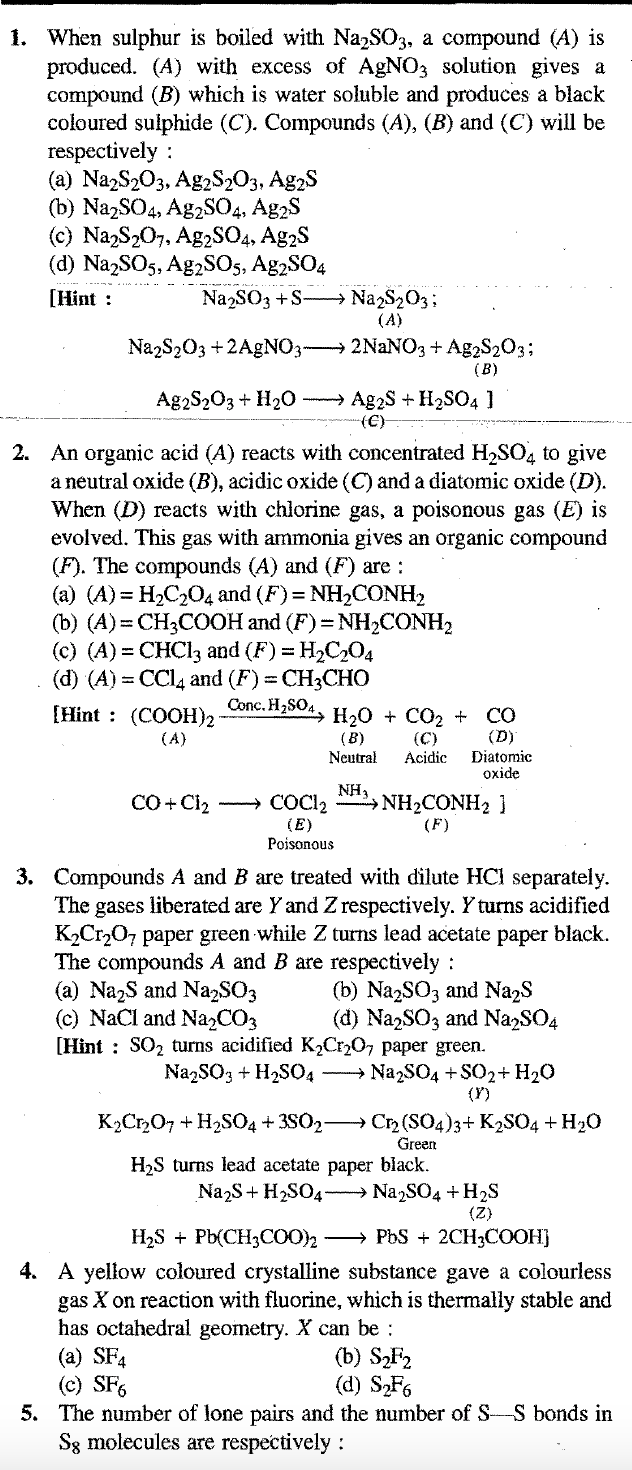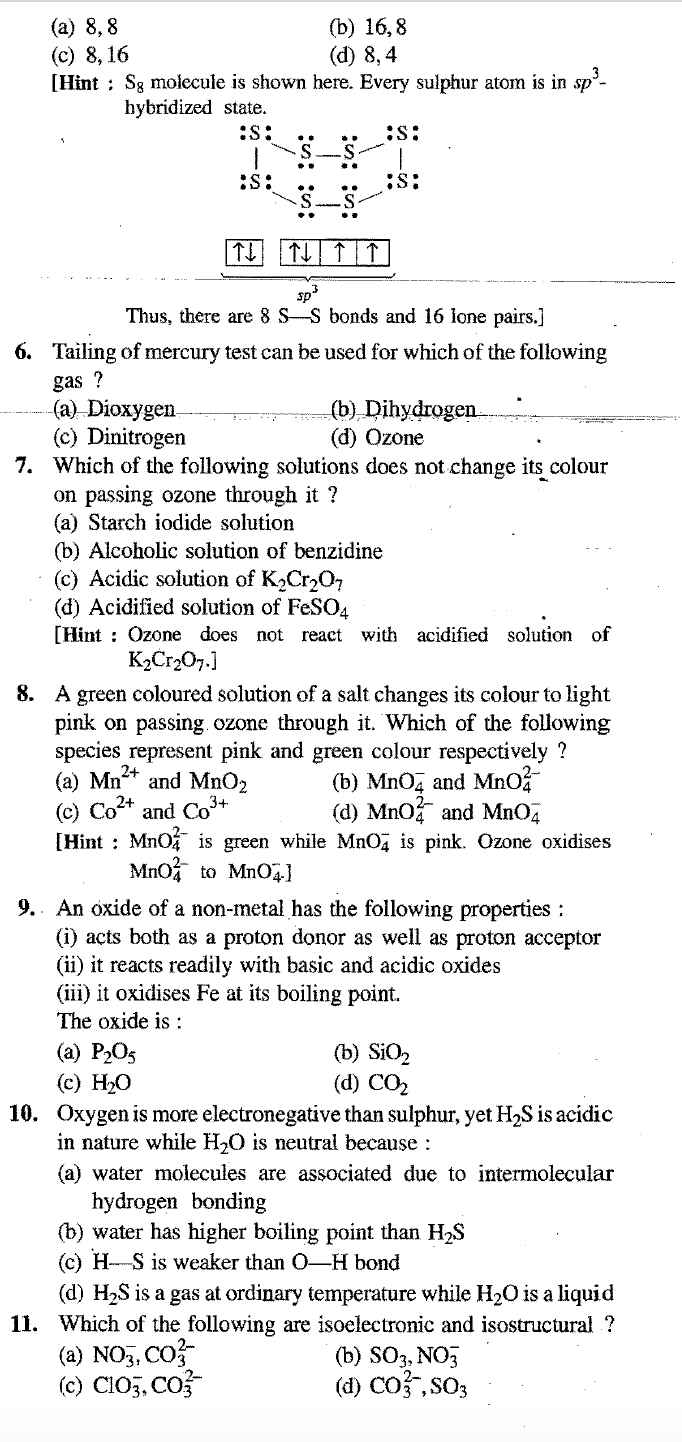Group 16 -4
Answers (1)
1: Sulphur and Sodium Sulfite:
Answer: (a) - Na₂S₂O₃, Ag₂S₂O₃, Ag₂S
Explanation: When sulfur is boiled with Na₂SO₃ (sodium sulfite), Na₂S₂O₃ (sodium thiosulfate) is formed (A). Reacting (A) with excess AgNO₃ (silver nitrate) produces Ag₂S₂O₃ (silver thiosulfate) (B), which is water-soluble. Further reaction of (B) with water leads to the formation of black colored Ag₂S (silver sulfide) (C).
2: Organic Acid and Sulfuric Acid:
Answer: (b) - (A) = CH₃COOH and (F) = NH₂CONH₂ (urea)
Explanation: CH₃COOH (acetic acid) (A) reacts with concentrated H₂SO₄ (sulfuric acid) to give CO₂ (neutral oxide) (B), SO₂ (acidic oxide) (C), and H₂O (diatomic oxide) (D). H₂O (D) reacts with Cl₂ (chlorine gas) to form HCl (poisonous gas) (E). HCl (E) with ammonia (NH₃) produces NH₂CONH₂ (urea) (F).
3: Dilute HCl with A and B:
Answer: (b) - Na₂SO₃ and Na₂S
Explanation: When Na₂SO₃ (sodium sulfite) (A) reacts with dilute HCl, SO₂ (gas) (Y) is liberated, which turns acidified dichromate paper green. Reacting Na₂S (sodium sulfide) (B) with dilute HCl produces H₂S (gas) (Z), which turns lead acetate paper black.
4: Yellow Crystalline Substance and Fluorine:
Answer: (c) - SF₆
Explanation: The yellow colored crystalline substance reacts with fluorine to form SF₆ (sulfur hexafluoride) (X), which is a colorless gas with a stable octahedral geometry due to the presence of six lone pairs on the central sulfur atom.
5: Lone Pairs and S-S Bonds in S₈:
Answer: (c) - 8, 16
Explanation: In the S₈ molecule, each sulfur atom has six valence electrons. Eight electrons are involved in forming four S-S single bonds, and the remaining eight electrons exist as lone pairs on the sulfur atoms.
6: Tailing of Mercury Test:
Answer: (d) - Ozone
Explanation: The tailing of mercury test is used to detect ozone (O₃) gas. Ozone reacts with mercury to form a white coating on the mercury surface, which disappears upon heating.
7: Solution Color Change with Ozone:
Answer: (b) - Alcoholic solution of benzidine
Explanation: Ozone reacts with many organic compounds, including benzidine, causing a color change. Other options, like starch iodide solution, acidic K₂Cr₂O₇ solution, and acidified FeSO₄ solution, will show a color change due to a reaction with ozone.
8: Green to Pink Color Change with Ozone:
Answer: (a) - Mn²+ (green) and MnO₄⁻ (pink)
Explanation: When ozone is passed through a green colored solution of Mn²+ salt, it gets oxidized to MnO₄⁻, resulting in a light pink color change.
9: Oxide Properties:
Answer: (a) - P₂O₅
Explanation: P₂O₅ (phosphorus pentoxide) exhibits all the given properties. It acts as a Brønsted-Lowry acid and base (i), reacts with basic and acidic oxides (ii), and oxidizes metals like Fe at high temperatures (iii).
10: Acidity of H2S and H2O:
Answer: (a) - water molecules are associated due to intermolecular hydrogen bonding
Explanation: Water molecules form intermolecular hydrogen bonds, which enhance the acidic character of H₂O by stabilizing the H⁺ ion released during dissociation. H₂S is a weaker acid compared to H₂O due to the weaker S-H bond compared to the O-H bond.
11: Isoelectronic and Isobstructural Species:
Answer: (c) - ClO3⁻, CO3²⁻
Explanation: Isoelectronic species have the same number of electrons, and isostructural species have the same structure. ClO3⁻ (chlorate ion) and CO3²⁻ (carbonate ion) have the same number of electrons (18) and a similar trigonal planar structure.



